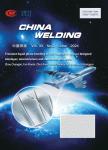Effect of Fe_(2)O_(3)nanoparticle on the interface microstructure and properties of Al/Cu plasma arc fusion-brazing joints
作者机构:Materials Science and Engineering CollegeLanzhou University of TechnologyLanzhou 730050China State Key Laboratory of Advanced Processing and Recycling of Non-Ferrous MetalsLanzhou 730050China
出 版 物:《China Welding》 (中国焊接(英文版))
年 卷 期:2023年第32卷第3期
页 面:10-20页
学科分类:080503[工学-材料加工工程] 08[工学] 0805[工学-材料科学与工程(可授工学、理学学位)] 0802[工学-机械工程] 080201[工学-机械制造及其自动化]
基 金:This work was supported by the National Natural Science Foundation of China(No.52165045)
主 题:Aluminum-copper dissimilar metals Fe_(2)O_(3)nanoparticles intermetallic compound mechanical properties conductive properties
摘 要:The lap joint of T2 copper plate and 1060 pure aluminum plate was made by using the plasma arc welding method with adding Fe_(2)O_(3)nanoparticles in different *** research analysis found that the thickness of the IMC(intermetallic compound)and eutect-ic region decreased after the addition of nanoparticles due to its inhibitory *** the proportion of Fe_(2)O_(3)nanoparticles is 3%,the in-terface intermetallic compound layer is the ***,after this ratio is continuously increased,the inhibition effect is weakened by the agglomeration of nanoparticles,and the thickness begins to increase *** mechanical and electrical properties of the joint are mainly affected by the thickness of the IMC *** nanoparticles are agglomerated into large particles with high ***,the tensile strength and relative electrical conductivity of the joint are first increasing and then decreasing with the increase of nanoparticle *** the proportion of nanoparticles is 3%,the tensile strength and electrical conductivity are maximum.



